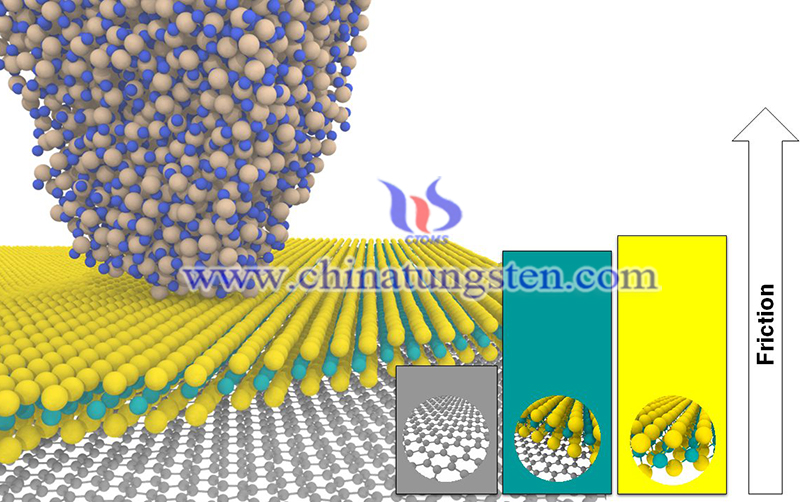MoS2 Core-Sheath Structure to Reduce Electromagnetic Pollution
- Details
- Category: Tungsten's News
- Published on Thursday, 24 December 2020 18:59
Recently, the team of Professor Liu Lei of Southeast University constructed a new core-sheath structure of MoS2 (CF@MXene@ MoS2 core-sheath structure) through electrostatic adsorption self-assembly and subsequent hydrothermal reaction, which can achieve tunable and efficient wave absorption to reduce small electromagnetic pollution.
A combination of two-dimensional (2D) materials and semiconductors is considered to be an effective way for fabricating photocatalysts for solving the environmental pollution and energy crisis. In this work, a novel 2D heterojunction of R-scheme Ti3C2 MXene/MoS2 nanosheets is successfully synthesized by hydrothermal reaction.
The photocatalytic activity of the Ti3C2 MXene/MoS2 composites is evaluated by photocatalytic degradation and hydrogen evolution reaction. Especially, 0.5 wt% Ti3C2 MXene/MoS2 sample exhibits optimum methyl orange (MO) degradation and H2 evolution rate of 97.4% and H2 evolution rate of 380.2 μmol h−1 g−1, respectively, which is attributed to the enhanced optical absorption ability and increased specific surface area.

Additionally, Ti3C2 MXene coupled with MoS2 nanosheets is favorable for improving the photocurrent response and reducing the electrochemical impedance, leading to the enhanced electron transfer of excited semiconductors and inhibition of charge recombination. This work demonstrates that Ti3C2 MXene could be a promising carrier to construct 2D heterojunction in photocatalytic degradation and hydrogen evolution reaction.
With the development of communication technology and the large-scale application of related equipment, various electronic devices not only bring convenience to people's lives, but also have potential effects on human health. To deal with increasingly serious electromagnetic pollution, people urgently need electromagnetic wave shielding and absorbing materials that can meet various needs.
Generally speaking, the design and construction of microwave absorbing (MA) materials include two component selection and structure design. One-dimensional MA-related materials benefit from anisotropy and high aspect ratio, and easily form carrier transmission paths along the axial direction under high-frequency electromagnetic fields, and consume electromagnetic wave energy through conduction losses.
Due to the intrinsic high specific surface area of two-dimensional MA-related materials. The material can dissipate electromagnetic waves through polarization enhancement at the interface and multiple reflections between layers. 3D MA-related materials can improve the impedance matching of the material by introducing voids, holes, etc. which is conducive to absorption loss. Recent studies have shown that the hierarchical 3D structure containing both 1D and 2D components holds excellent absorbing properties.
In summary, 2D heterojunction of R-scheme Ti3C2 MXene/MoS2 composites is successfully synthesized by the hydrothermal method. The Ti3C2 MXene/MoS2 photocatalysts display remarkably enhanced photocatalytic activity for the degradation of MO and H2 evolution reaction compared with pristine MoS2.
The 0.5 wt% Ti3C2 MXene/MoS2 sample reaches an optimum MO degradation of 97.4% after 30 min irradiation and hydrogen evolution rate of 380.2 μmol h−1 g−1 under visible irradiation. The morphology and structure analysis confirm that MoS2 nanosheets are induced by ultrathin Ti3C2 MXene from crouching to stretching, which may greatly increase the specific surface area and enhance the light absorption ability.
More importantly, Ti3C2 MXene coupled with MoS2 nanosheets can effectively receive and transfer electrons from excited semiconductor, which is beneficial to suppress the charge recombination and improve the interface charge transfer processes as well as reduce electromagnetic pollution. In this work, the constructed novel 2D heterojunction of R-scheme Ti3C2 MXene/MoS2 demonstrates that Ti3C2 MXene can become a promising cocatalyst in photocatalytic reaction.
| Molybdenum Supplier: Chinatungsten Online www.molybdenum.com.cn | Tel.: 86 592 5129696; Fax: 86 592 5129797;Email:sales@chinatungsten.com |
| Tungsten News & Prices, 3G Version: http://3g.chinatungsten.com | Molybdenum News & Molybdenum Price: http://news.molybdenum.com.cn |



 sales@chinatungsten.com
sales@chinatungsten.com